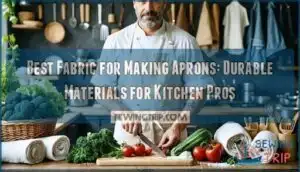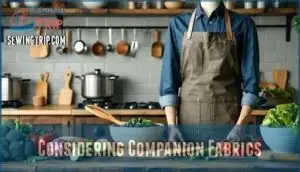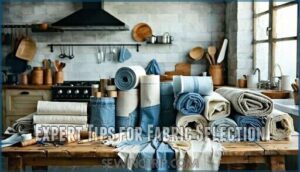This site is supported by our readers. We may earn a commission, at no cost to you, if you purchase through links.
 Cotton canvas stands as the gold standard when choosing the best fabric for making aprons. This heavyweight material resists stains, withstands frequent washing, and gets softer with each use.
Cotton canvas stands as the gold standard when choosing the best fabric for making aprons. This heavyweight material resists stains, withstands frequent washing, and gets softer with each use.
Denim offers similar durability with a casual vibe, while cotton twill provides a professional appearance that’s lighter than canvas.
For easy-care options, cotton-polyester blends combine natural comfort with synthetic resilience. Avoid pure linen—it wrinkles like a roadmap and stains easily.
Consider your kitchen’s demands: heavy-duty cooking calls for canvas, while light prep work suits cotton. The right fabric choice affects everything from pocket placement to strap construction.
Table Of Contents
Key Takeaways
- Choose cotton canvas for heavy-duty cooking – It’s the gold standard that resists stains, withstands frequent washing, and gets softer over time
- Match fabric weight to your cooking style – Heavy canvas for messy work, lighter cotton for baking, and cotton-polyester blends for everyday tasks
- Consider cross-back straps and deep pockets – These design features distribute weight evenly and keep essential tools within reach during long kitchen sessions
- Test fabric compatibility before buying – Make sure companion fabrics have smaller prints and harmonizing colors to create visual balance without competing with your main fabric choice
Choosing Apron Fabric
When you’re choosing fabric for your apron, the material you select determines how well it’ll protect your clothes and how long it’ll last through countless kitchen battles.
Your fabric choice makes or breaks your apron’s kitchen survival story.
The right fabric choice means the difference between an apron that becomes your trusted kitchen companion and one that falls apart after a few messy cooking sessions, making it a crucial decision for a trusted kitchen companion.
Fabric Types
Several fabric options offer distinct advantages for crafting professional-grade aprons.
Cotton benefits include breathability and easy maintenance, making it ideal for everyday kitchen use.
Linen advantages encompass superior moisture absorption and natural cooling properties.
Denim durability withstands heavy-duty tasks while developing character over time.
- Cotton canvas providing lightweight protection for baking sessions
- Heavy denim shielding against workshop sparks and spills
- Crisp linen keeping you cool during marathon meal prep
- Sturdy duck cloth standing up to commercial kitchen demands
Thickness Matters
When choosing durable apron fabric, thickness makes all the difference between professional-grade protection and disappointment.
Heavy-weight materials like cotton duck or canvas provide superior abrasion resistance against daily kitchen chaos. These substantial fabrics offer excellent heat protection and spill resistance that lightweight alternatives can’t match.
Apron fabric weight directly impacts durability—heavier options withstand repeated washing while maintaining their protective qualities. Consider fabric thickness for layering potential too, as thicker materials shield your clothing more effectively.
Smart fabric selection means prioritizing apron fabric durability over aesthetics for long-lasting performance. Fabrics like cotton offer breathability and softness, adding to the comfort of the wearer.
Considering Companion Fabrics
When selecting companion fabrics for your apron, you’ll want to choose materials that complement rather than compete with your main fabric choice.
The companion fabric should feature smaller prints and harmonizing colors to create visual balance while maintaining the apron’s professional appearance.
Coordination With Main Fabric
Your companion apron fabric should create perfect fabric pairing with your main choice. When the primary fabric features busy patterns, select companions with smaller print size for visual balance.
Achieve color harmony by matching undertones while avoiding white-heavy combinations that appear washed out. Consider fabric direction strategically – stripes work beautifully because you can rotate them for interest.
Test different fabric matching combinations until the apron design flows naturally, ensuring pattern harmony throughout your finished piece. This process helps in creating a visually appealing apron by maintaining visual balance.
Patterns and Color
When selecting apron fabric patterns and colors, you’ll want to master the art of visual balance. Print size plays a vital role—large, vibrant patterns work beautifully on apron skirts, while smaller designs suit pockets and trim details.
- Stripe direction creates visual interest when you vary fabric direction across different apron sections—try horizontal stripes on the bodice with vertical ones on the hem band
- Color harmony guarantees your companion fabrics complement rather than compete, avoiding excessive white combinations that can appear bland or sterile
- Apron fabric designs should reflect your personality while maintaining professional appeal—mix polka dots with florals or geometric patterns with organic shapes
Smart color combinations elevate ordinary aprons into standout pieces that’ll make your kitchen work more enjoyable.
Ideal Fabric Features
When you’re selecting fabric for your apron, focus on features that enhance both functionality and comfort during long kitchen sessions.
The best apron fabrics combine practical elements like cross-back straps for even weight distribution, deep pockets for essential tools, and full coverage protection that shields your clothes from spills and splatters.
Cross-Back Straps
Cross-back straps revolutionize strap comfort by distributing your apron’s weight evenly across both shoulders instead of straining your neck.
Cross-back straps turn kitchen marathons into comfortable workdays by spreading weight across your shoulders.
You’ll appreciate how cross-back ergonomics enhance the overall wearing experience during long kitchen shifts.
Choose durable apron fabric types like 12-16 oz. canvas or denim for superior strap durability.
These apron sewing fabric options handle repeated stretching without fraying, and looking for adjustability options with buckles or ties to customize fit is also important.
Quality fabric guarantees your crossback straps maintain their supportive structure wash after wash, making aprons both functional and comfortable for professional use.
Deep Functional Pockets
Beyond comfortable straps, your apron needs well-designed pockets for maximum apron functionality.
Thoughtful pocket dimensions guarantee tool accessibility while maintaining weight distribution across your apron fabric.
- Minimum 7-8 inch depth – accommodates bulky utensils and tablets
- Reinforced pocket construction – double-stitched seams prevent tearing
- Strategic placement – positioned between waist and thigh for ergonomic reach
- Secure closures – snaps or velcro keep contents safe during movement
Quality apron pockets transform ordinary aprons into professional workstations, keeping essential tools within arm’s reach.
You can find aprons with extra strong pockets for added durability.
Full Coverage
When you’re tackling messy kitchen tasks, you need apron fabric that wraps around your body like armor. Maximum Protection starts with choosing a full bib style that shields your chest, torso, and lap from inevitable splatters.
The right apron fabric creates a waterproof barrier against liquids while maintaining body movement flexibility.
Fabric weight plays a vital role in coverage—heavier materials like canvas or denim provide superior apron protection compared to flimsy alternatives.
These durable options offer excellent heat resistance for stovetop work while ensuring apron fabric durability through countless wash cycles.
Cross-back straps distribute weight evenly across your shoulders, preventing neck strain during extended wear.
Unlike loop-neck designs that dig in, cross-back styles move with your body naturally.
Think of your apron as a trusty shield that shouldn’t restrict your culinary dance around the kitchen.
The ideal protective apron becomes an extension of yourself—covering vulnerable areas without hampering your cooking rhythm or comfort level.
Matching Apron to Your Needs
Finding the right apron fabric means matching your specific needs to the material’s strengths.
Consider your workplace requirements, personal preferences, and the apron style that’ll work best for your daily tasks, which involves finding an apron that meets these needs.
Uniform or Workplace Requirements
Your place of employment sets the foundation for fabric selection, and understanding workplace dress codes guarantees compliance with industry standards.
Many corporate environments require specific colors that align with corporate branding while maintaining professional appearance throughout your shift.
Consider these essential workplace factors:
- Safety regulations – Fire-resistant cotton for commercial kitchens, chemical-resistant PVC for laboratories
- Specific professions – Heavy canvas for welding shops, antimicrobial polyester for healthcare settings
- Employee comfort – Breathable fabrics for hot shop environments, moisture-wicking blends for long shifts
- Duties requirements – Stain-resistant materials for messy tasks, waterproof fabrics for dishwashing stations
Your aprons become professional tools when they match your work environment’s demands and safety protocols.
For chef aprons, consider options like heavyweight canvas for enhanced durability.
Personal Fabric Preferences
Your personal fabric preferences shape every aspect of your apron’s character.
Comfort considerations like fabric feel against skin matter, especially if you have personal allergies or sensory preferences.
Choose apron fabric that speaks to you—whether you love cotton’s softness or canvas’s sturdy texture.
Style choices in fabric aesthetics transform basic protection into personal expression.
Your fabric choices drive successful apron customization, creating pieces that feel uniquely yours through thoughtful apron styling.
Apron Style and Design
Smart fabric choices transform ordinary aprons into functional kitchen gear.
Your apron style determines which materials work best and how you’ll customize the final design.
- Apron silhouettes – Full-coverage bib styles need sturdy canvas, while bistro aprons work with lighter cotton
- Pocket placement – Deep pockets require reinforced fabric backing for durability and structure
- Strap styles – Cross-back designs need flexible materials that won’t dig into shoulders
- Color blocking – Bold fabric design choices create visual interest and hide stains effectively
- Custom embellishments – Dense weaves hold embroidery better than loose-knit materials
Match your apron pattern to your fabric’s personality – structured designs demand crisp cotton while flowing styles embrace softer linens.
Expert Tips for Fabric Selection
Selecting the right fabric transforms your apron from a simple kitchen accessory into a durable workhorse that’ll handle whatever you throw at it.
You’ll want to take into account durability factors like thread count and stain resistance alongside aesthetic elements like color coordination and pattern placement to create an apron that’s both functional and visually appealing.
Fabric for Apron Durability
Your apron’s battle-ready fabric determines whether it’ll survive countless kitchen adventures or surrender after a few sauce splatters.
Cotton canvas and denim reign supreme for durability, with canvas boasting 30-35 MPa tensile strength and denim resisting 8,000 abrasion cycles.
| Fabric Feature | High Performance | Standard Performance |
|---|---|---|
| Thread Count | 300+ threads/inch | 150-250 threads/inch |
| Material Resilience | Retains 95% strength after 50 washes | Loses 10-15% strength |
| Stain Resistance | Repels 85% of spills | Basic protection |
| Abrasion Resistance | 8,000+ cycles | 3,000-5,000 cycles |
| Weave Strength | Tight twill/canvas weave | Loose plain weave |
Choose thick apron fabric with high thread count for maximum apron lifespan and strength.
Consider exploring options for enhanced apron materials to further increase longevity.
Fabric Colors and Designs
Beyond durability, color psychology plays a pivotal role in your apron design.
Pattern direction and print size affect visual impact—large prints work beautifully on apron skirts while smaller designs balance companion fabrics. Consider fabric texture alongside design elements for perfect harmony.
Transform your kitchen style with:
- Bold stripe patterns that energize your cooking routine
- Artistic prints that spark conversation with guests
- Rich textures that feel as good as they look
- Personal colors that make you smile while working
Decorative touches through thoughtful apron fabric colors create design balance. Your fabric print becomes an extension of your personality, turning mundane kitchen tasks into creative expression. To achieve this balance, consider how tertiary colors add complexity.
Companion Fabric Considerations
When selecting companion fabric, prioritize print size and color harmony to achieve fabric coordination.
Choose smaller prints than your main apron fabric for pattern balance.
Avoid excessive white in fabric selection, as it creates bland combinations.
Consider fabric direction for visual interest—stripes work beautifully across different apron sections.
Smart fabric compatibility guarantees your companion fabric enhances rather than competes with your primary choice.
Understanding companion fabrics is vital for making informed decisions about apron materials.
Where to Find Quality Apron Fabrics
Your fabric selection skills are solid – now you need to know where to find these materials. Quality apron fabrics aren’t just hiding in one corner of the internet. You’ll discover options everywhere from your neighborhood craft shops to specialized online markets.
Fabric Stores remain your best bet for hands-on evaluation. Over 70% of major city fabric stores stock dedicated workwear sections with canvas, twill, and denim perfect for aprons. Staff expertise helps you assess thickness and drape before buying.
Online Markets offer massive selection with 500,000+ listings for apron-appropriate materials. Search filters let you sort by thickness and durability ratings. Top vendors include detailed care instructions and honest reviews.
Discount Outlets and thrift stores provide budget-friendly alternatives, while Vintage Shops offer unique materials with character. For larger projects, apron fabric wholesale suppliers slash costs by 45% on bulk orders exceeding 100 yards.
- Independent craft shops run monthly sales on utility-weight cotton and heavy linen
- Digital apron fabric online marketplaces report 40% growth in waterproof fabric transactions since 2023
- Local fabric manufacturer partnerships often provide customization services for commercial buyers
When choosing the best fabric, consider the importance of fabric material requirements to guarantee durability and stain resistance.
Frequently Asked Questions (FAQs)
How Do I Get Stains Out of My Apron Fabric?
Act quickly when stains happen – they’re easier to tackle fresh.
For cotton aprons, soak in cold water first, then machine wash with enzyme detergent.
Tough stains need bleach treatment or immediate spot cleaning before they set permanently.
Where Can I Buy Affordable Apron Fabric Online or in Stores?
You can find affordable apron fabric at discount outlets, thrift stores, craft stores like Jo-Ann’s, and Etsy for unique options that won’t break the bank.
Are There Any Eco-friendly or Sustainable Apron Fabric Options?
Green threads weave hope into your apron-making journey.
You’ll discover organic cotton, hemp, and linen options that protect both you and Earth.
These sustainable fabrics resist stains naturally while supporting eco-friendly practices through responsible sourcing.
What fabric is best to make an apron?
Cotton stands as your best bet for apron-making, offering breathability, durability, and easy washing. For heavy-duty work, consider canvas or denim for extra protection against spills and heat.
Is cotton or polyester better for aprons?
Cotton wins for comfort and breathability, making it perfect for baking and dry work.
Polyester excels at stain resistance and quick drying, ideal for messy cooking tasks that’ll test your apron’s limits daily.
What fabric are chef aprons made of?
When the rubber meets the road in professional kitchens, you’ll find chef aprons made from cotton or cotton blends.
These fabrics offer breathability, durability, and easy washing that busy chefs need daily.
What is the best waterproof fabric for aprons?
Nylon and rubber offer top-tier waterproof protection for aprons.
You’ll find nylon resists water while staying flexible, making cleanup easier.
Rubber provides complete waterproof coverage but feels heavier during extended wear, and nylon offers flexibility, making it a better choice for extended wear.
How much fabric needed for standard apron?
Like a tailor measuring twice to cut once, you’ll need 5 to 5 yards depending on your apron style. Full bib aprons require more fabric than simple waist styles.
Can synthetic blends work for cooking aprons?
Yes, synthetic blends work well for cooking aprons.
Polyester-cotton blends with high polyester content offer excellent stain resistance, wrinkle resistance, and durability.
They’re easy to clean and maintain their shape better than pure cotton, which is a key factor in their durability.
What weight fabric works best for beginners?
Think of fabric weight as your training wheels—medium-weight cotton around 7-9 oz offers the sweet spot for beginners.
It’s forgiving during construction, handles mistakes gracefully, and won’t overwhelm your sewing skills while providing decent protection, making it an ideal choice for those starting out with medium-weight cotton.
Conclusion
Selecting the best fabric for making aprons is like choosing armor for battle—it needs to withstand whatever your kitchen throws at it.
Cotton canvas remains the champion for heavy-duty use, while denim and cotton twill offer excellent alternatives.
You’ll find cotton-polyester blends perfect for everyday cooking tasks.
Remember to match your fabric choice to your cooking style and maintenance preferences.
With the right material, you’ll create aprons that serve you reliably for years.
- https://www.cosmicaprons.com/blogs/news/5-durable-apron-fabrics-for-long-lasting-use
- https://fergusonsirishlinen.com/blogs/blog/linen-apron-vs-cotton-apron-which-is-better-and-why-it-s-linen
- https://reluctantthreads.com/pages/apron-comparison-100-cotton-wrinkle-resistant-poly-blend
- https://stockmfgco.com/blogs/stories/choosing-the-correct-apron-fabric-for-your-uniform
- https://www.nytimes.com/wirecutter/reviews/our-favorite-kitchen-aprons/












